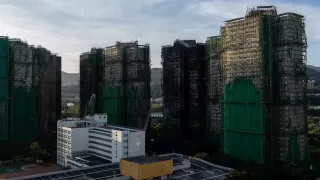When we think of ancient mysteries, our imagination often drifts toward the stars. But the real enigma might be hidden much closer—right beneath our feet. The Pyramids of Giza, those towering monuments of ancient engineering, have captivated scholars and explorers for centuries. Yet, beneath the sands of time, they seem to guard even greater secrets. Recent findings by a team of Italian archaeologists have unveiled something extraordinary—an underground city beneath the Pyramid of Khafre, a discovery that could change everything we know about ancient Egypt.
Italian researchers from the University of Pisa, led by renowned archaeologist Corrado Malanga, have reported the discovery of a vast network of tunnels, chambers, and a sophisticated water system lying more than 650 meters beneath the Pyramid of Khafre. This revelation suggests the existence of a subterranean city that may have been built long before the pyramids themselves.
What’s astonishing is that these hidden pathways appear to be intricately connected to the pyramid's foundation, possibly providing structural support to the mammoth weight of Khafre’s monument. The wells identified beneath the pyramid range from 10 to 12 meters in diameter, a size that could potentially stabilize the structure and prevent it from collapsing over time.
This breakthrough was made possible through the use of ground-penetrating radar (GPR), a technology that scans beneath the surface much like an X-ray scans the human body. These radars send electromagnetic pulses into the ground, which bounce back upon encountering solid objects, mapping out hidden structures without disturbing the surrounding environment.
Through this advanced imaging technique, the researchers could trace the layout of the underground system, capturing a glimpse of what might be one of the oldest and most complex subterranean networks ever discovered. Estimated to be over 4,000 years old, this underground system predates known architectural developments, raising questions about whether ancient Egyptians had knowledge of engineering that surpassed their time.
The implications of this discovery are profound. Historians have long debated whether the pyramids were solely tombs for the pharaohs or had other hidden purposes. However, if an entire city or advanced structure lies beneath Khafre’s pyramid, it suggests that ancient Egyptians may have had more knowledge about urban planning and subterranean architecture than previously believed.
Ancient texts and oral traditions have often hinted at the existence of secret chambers and passageways under the pyramids, but solid evidence has always been elusive—until now. Some theorists speculate that this hidden city could have served as a sanctuary for the elite or a ceremonial center connected to ancient rituals. Others suggest it might have been a fortress or a hub for advanced knowledge, protected beneath the sands for millennia.
As with any discovery of this magnitude, skepticism abounds. Lawrence Conyers, a leading radar specialist from the University of Denver, has raised concerns, arguing that current radar technology is not capable of penetrating the ground deeply enough to detect a fully developed underground city at such a depth. He suggests that while small chambers and tunnels may exist, the claim of an entire city may be exaggerated or misinterpreted.
However, Malanga and his team remain confident in their findings, emphasizing that further data analysis and excavations could provide undeniable proof of their discovery. The Egyptian government has since restricted access to the site, fueling speculation and intrigue about what lies beneath.
If proven true, this discovery could lead to a radical shift in our understanding of ancient civilizations. It may reveal architectural innovations that challenge modern assumptions about technological progress and shed light on the lives of the people who once walked these ancient corridors.
Moreover, the discovery raises new questions. Could this underground city be connected to other pyramids? Was it built before or after the pyramids? What secrets do these chambers hold about the spiritual and societal life of ancient Egyptians? For now, much remains unknown, but researchers are determined to continue their exploration.
The pyramids of Giza have stood for thousands of years, silently guarding the secrets of the past. But with the discovery of this underground world, it’s clear that we are only beginning to scratch the surface of their mysteries. As more maps and scans are analyzed, and with further advancements in archaeological technology, we may soon unlock truths that have been buried beneath the sands of Giza for millennia.
Who knows what else lies hidden beneath the desert? Perhaps the greatest revelations of human history are still waiting to be unearthed. Until then, the story of the pyramids continues to unfold—one discovery at a time.
Also Read: ChatGPT New Image Update: Amazing Quality, But Not for All Yet

























